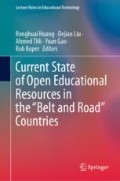Abstract
The rapidly changing world requires that lifelong learning must become an integral part of people’s life. This challenge is especially apparent in the small countries with limited human resources. Open educational resources and practices should be seen as a part of larger learning ecosystem to improve access and increase the quality of education. This chapter presents the current situation of open education in Estonia. The development of digital learning resources infrastructure which also cover open educational resources is currently among the priorities in Estonia. In addition to the infrastructure development, there have been large projects for creating open educational resources for schools. However, Estonia does not have a specific open educational policy and a functional open education community. Also there is very little research on the actual use and impact of open educational resources.
Access this chapter
Tax calculation will be finalised at checkout
Purchases are for personal use only
References
Camilleri, A. F., Ehlers, U.-D., & Pawlowski, J. (2014). State of the art review of quality issues related to Open Educational Resources (OER). Report No. EUR 26624 EN. Retrieved from Institute for Prospective Technological Studies website. https://is.jrc.ec.europa.eu/pages/EAP/documents/201405JRC88304.pdf
Hariduspilv (Education Cloud). (2014). Retrieved from https://www.hm.ee/en/activities/digital-focus/hariduspilv-education-cloud
Kasprzak, T., Jurkowska, O., & Tarkowski, A. (2017). Creator, rebel, guardian, unsuspecting user: Teachers and modern educational practices (pp. 1–34). Warsaw: Communia. Retrieved from https://rightcopyright.eu/wp-content/uploads/2017/04/Teachers-and-modern-educational-practices.pdf
Kikkas, K., Laanpere, M., & Põldoja, H. (2011). Open Courses: The next big thing in eLearning. In A. Rospigliosi (Ed.), Proceedings of the 10th European Conference on e-Learning (pp. 370–376). Reading: Academic Publishing Limited.
Krelja Kurelovic, E. (2015). Advantages and limitations of usage of open educational resources in small countries. International Journal of Research in Education and Science, 2(1), 136–142.
Laanpere, M., Pata, K., Normak, P., & Põldoja, H. (2014). Pedagogy-driven design of digital learning ecosystems. Computer Science and Information Systems, 11(1), 419–442. https://doi.org/10.2298/CSIS121204015L
Leinonen, T., Purma, J., Põldoja, H., & Toikkanen, T. (2010). Information architecture and design solutions scaffolding authoring of open educational resources. IEEE Transactions on Learning Technologies, 3(2), 116–128. https://doi.org/10.1109/TLT.2010.2
Leito, I., Helm, I., & Jalukse, L. (2015). Using MOOCs for teaching analytical chemistry: Experience at University of Tartu. Analytical and Bioanalytical Chemistry, 407(5), 1277–1281. https://doi.org/10.1007/s00216-014-8399-y
Lepp, M., Luik, P., Palts, T., Papli, K., Suviste, R., Säde, M., & Tõnisson, E. (2017). MOOC in programming: A success story. In L. Campbell & R. Hartshorne (Eds.), 12th international conference on e-Learning (ICEL 2017) (pp. 138–147). Sonning Common: Academic Conferences and Publishing International.
MER. (2014). The Estonian lifelong learning strategy 2020. Retrieved from https://www.hm.ee/sites/default/files/estonian_lifelong_strategy.pdf
OECD. (2014). Talis 2013 results: An international perspective on teaching and learning. OECD Publishing. https://doi.org/10.1787/9789264196261-en
OECD. (2016). PISA 2015 Results (Volume I): Excellence and equity in education. Paris: OECD Publishing. https://doi.org/10.1787/9789264266490-en
Pata, K., Beliaev, A., Rõbtšenkov, R., & Laanpere, M. (2017). Affordances of the LePlanner for sharing digitally enhanced learning scenarios. In M. Chang, N.-S. Chen, R. Huang, Kinshuk, D. G. Sampson, & R. Vasiu (Eds.), IEEE 17th international conference on advanced learning technologies (pp. 8–12). Los Alamitos, CA: IEEE Computer Society. https://doi.org/10.1109/ICALT.2017.77
Pedaste, M., De Vries, B., Burget, M., Bardone, E., Brikker, M., Jaakkola, T., et al. (2015). Ark of inquiry: Responsible research and innovation through computer-based inquiry learning. In H. Ogata, W. Chen, S. C. Kong, & F. Qiu (Eds.), Workshop proceedings of the rd international conference on computers in education ICCE 2015 (pp. 187–192). Asia-Pacific Society for Computers in Education.
Põldoja, H., Duval, E., & Leinonen, T. (2016). Design and evaluation of an online tool for open learning with blogs. Australasian Journal of Educational Technology, 32(2), 64–81. https://dx.doi.org/10.14742/ajet.2450
Põldoja, H., Jürgens, P., & Laanpere, M. (2016). Design patterns for badge systems in higher education. In M. Spaniol, M. Temperini, D.K.W. Chiu, I. Marenzi, & U. Nanni (Eds.), Advances in web-based learning—ICWL 2016 (Vol. 10013, pp. 40–49). Cham: Springer. https://dx.doi.org/10.1007/978-3-319-47440-3_5
Tomberg, V., Laanpere, M., Ley, T., & Normak, P. (2013). Sustaining teacher control in a blog-based personal learning environment. The International Review of Research in Open and Distance Learning, 14(3), 109–133. https://dx.doi.org/10.19173/irrodl.v14i3.1397
Väljataga, T., & Laanpere, M. (2010). Learner control and personal learning environment: A challenge for instructional design. Interactive Learning Environments, 18(3), 277–291. https://doi.org/10.1080/10494820.2010.500546
Author information
Authors and Affiliations
Corresponding author
Editor information
Editors and Affiliations
Rights and permissions
Copyright information
© 2020 Springer Nature Singapore Pte Ltd.
About this chapter
Cite this chapter
Põldoja, H., Laanpere, M. (2020). Open Educational Resources in Estonia. In: Huang, R., Liu, D., Tlili, A., Gao, Y., Koper, R. (eds) Current State of Open Educational Resources in the “Belt and Road” Countries. Lecture Notes in Educational Technology. Springer, Singapore. https://doi.org/10.1007/978-981-15-3040-1_3
Download citation
DOI: https://doi.org/10.1007/978-981-15-3040-1_3
Published:
Publisher Name: Springer, Singapore
Print ISBN: 978-981-15-3039-5
Online ISBN: 978-981-15-3040-1
eBook Packages: EducationEducation (R0)

